EXCEPTS FROM CHINESE DANCE
by Sun Jingchen, Luo Xiongyan, Zi Huayun
Bright and Colorful Modern Chinese Dance - Folk and Classical
At the beginning of the 1950s, encouraged and implemented by the government, the work of "heritage salvation" started on a large scale. In the field of dance, people on the one hand effectively investigated, collected and sorted out folk dances scattered among the many different ethnic groups and brought their essence onto the stage; on the other hand, they inherited the drama dances and developed them into a kind of independent dance art.
The folk dances, especially those requiring high skills, featured excellent dancers, most of whom were peasants who had for a long time suffered from hunger and vagrancy. The "heritage salvation" movement was designed to 'rescue' these folk artists and help them win unprecedented respect of their fellow countrymen.
Over the decades of , a lot of excellent dances emerged, which had strong local flavors and reflected people's spirit of the times. Not only were these dances loved by common people, they also attracted world attention in international cultural exchanges. Remarkable works included the "Lotus Dance" and "Flying Apsaras" of Dai Ailian and "Erdos Dance" of jia Zuoguang.
The "Red Silk [Ribbon] Dance" is a group dance which debuted in 1949,. (Choreographer: jin Ming [1927- ]; composer: Cheng Yun; premieres: Zheng Jianji, Wang Yabin and Liu Hairu of the Changchun Art Troupe.) This dance features a group of men and women held high their "torches" while happily dancing yangge. Then the "torches" turned into red silks [ribbons], flying like a fire dragon. The vigorous movements and changing "fire dragon" give brilliance to each other and create a scene of youth...
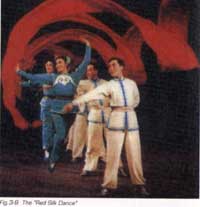 The dance was performed in Beijing in 1950 and caused a sensation in the capital. The next year, it was selected for the Third World Youth FestivaI and won a gold award. In the following half century, it was presented throughout China and the world. People regarded it as "a symbol of Chinese fire". (Fig.3-9)
The dance was performed in Beijing in 1950 and caused a sensation in the capital. The next year, it was selected for the Third World Youth FestivaI and won a gold award. In the following half century, it was presented throughout China and the world. People regarded it as "a symbol of Chinese fire". (Fig.3-9)
Other dances of the Han nationality, including the "Flower Drum Dance" and the "Harvest Song", are also Outstanding. The "Flower Drum Dance" is a group dance which debuted in 1956. (Choreographer: Zhang Yi [1934- ]; composer: Yi Ming; premiere: Dalian Song and Dance Ensemble led by Zhang Yi.) The dance of "flower drum" is popular in Shandong Province. During a long period, it was a way of making a living for the poor a half-meter long tassel is tied to the drumstick. The dancer beats the drum alternatively with the stick and the tassel. Zhang Yi in his performance lengthened the tassel to highlight his skill. To the inspiring and varied rhythm, the dancer's vigorous and graceful movements with colorful tassels, create a unique charm.
 The "Harvest Song" is a female group dance which debuted in 1964. (Choreographer: Huang Sujia [female, 1936- ] and Li Yulan; composers: Zhu Nanxi and Zhang Mulu; premieres: Li Kuinan and others with the Qianxian [Frontline] Song and Dance Ensemble of the Political Department of Nanjing Military District.) ... Choreographer Huang Sujia went to the South many times and was deeply impressed by the hard-working women and their joy after the harvest. She combined delicately the actions in reaping and movements of dancing and reproduced the beautiful and unrestrained southern Chinese girls with fast rhythms and vigorous body movements. The climax came when the waistbands of peasant girls turn into "Surging golden waves". The three works mentioned above are all listed among the Dance Classics of the Chinese Nation in the 20th Century.
The "Harvest Song" is a female group dance which debuted in 1964. (Choreographer: Huang Sujia [female, 1936- ] and Li Yulan; composers: Zhu Nanxi and Zhang Mulu; premieres: Li Kuinan and others with the Qianxian [Frontline] Song and Dance Ensemble of the Political Department of Nanjing Military District.) ... Choreographer Huang Sujia went to the South many times and was deeply impressed by the hard-working women and their joy after the harvest. She combined delicately the actions in reaping and movements of dancing and reproduced the beautiful and unrestrained southern Chinese girls with fast rhythms and vigorous body movements. The climax came when the waistbands of peasant girls turn into "Surging golden waves". The three works mentioned above are all listed among the Dance Classics of the Chinese Nation in the 20th Century.
"Peacock Dance" (a female group dance) is another remarkable work created by jin Ming. It was first put on stage in 1956, composed by Luo Zhongrong and premiered and led by Zi Huayun and Cui Meishan of the Central Song and Dance Ensemble. A "peacock", with its tail feathers spreading, rushes down from a high hill. Its wings changed into the "peacock girls", who dance around the "King of Birds" according to the beat of foot drums and gongs. With this graceful rhythm, they drink, bathe and fly.
The peacock was a totem worshipped by the Dai ethnic group on the southwest border of China. It has always been seen as a symbol of fortune and happiness. According to folk customs, the "peacock dance" used to be performed by males. They had to shoulder heavy stage props such as wings, therefore, their actions were restrained. Breaking through the boundaries of tradition, the creators tried to display peacock's beauty by giving the part to women. They got rid of the heavy wings and they wore long broad skirts decorated with peacock feathers. When the dance debuted at the national dance festival in 1956, it found great favor with audiences for its uniqueness and elegance. The next year, it won a gold award in the World Youth Festival.
Many excellent dance works were cultivated during the collection of traditional folk dances. The government began holding regular art festivals in order to exchange experiences and develop a creative spirit. All ethnic groups are proud of their own dances that have been brought to the stage. Due to historical reasons, however, dances of some minority nationalities in some areas are on the verge of extinction. People of these ethnic groups, therefore, suggested that professional choreographers design a dance program for them. The "Happy Luo Suo" and "Straw Hat Dance" were hence created in response to this.
The "Happy Luo Suo" is a group dance which debuted in 1959. (Choreographer: Leng Maohong [1938- ]; composer: Yang Yusheng; premieres: Leng Maohong and others with the Liangshan Yi Autonomous Prefecture Song and Dance Ensemble.) "Luo Suo" means the Yi nationality according to its language. Before 1949, the ethnic group lived in a community in the Big and Small Liangshan Mountains of Sichuan Province (with some others found in Yunnan and southwest provinces). They lived with the system of slavery. After the PLA came and abolished slavery, people there began to develop production and their new life began to flourish with each passing day. Leng Maohong saw the great changes himself and was inspired by the joy of the Yi people on their liberation.
He set up a basic style for his dance from actions at the sacrificial ceremony, such as "limping steps" and "whirling skirts". The extremely quick feet and hands expressed Luo Suo's pursuit for freedom. Accompanied by a simple and unique Yi melody, the dancers shouted with joy when they shook off the shackles of oppress ion. The dance was well received not only in the Liangshan Mountain areas and other parts of China, but also in the world.
The "Straw Hat Dance" is a group female dance which debuted in 1960. (Choreographer: Chen Qiao [female, 1938- ]; composer: Li Chaoran; premieres: Han Aitao and others from the Song and Dance Ensemble of the Li Nationality Autonomous Prefecture of Hainan.) Girls of the Li ethnic group love straw hats very much. They use them to protect themselves from the sun and rain when working in the field. on sunny mornings, girls go to fields in high spirits. The straw hats look like lotus leaves flying on the horizon. When the sun sets, they come home with their hats tied to their waists, looking like moving wheels. The straw hats flow and jump with these girls, creating a Fig. with a strong local flavor.
The choreographer Chen Qiao spent her youth on Hainan island where the Li people live. She became familiar with the folk customs and ways of expression of the ethnic group. All the movements she designed, including putting the hands on the waist, hip thrusts, tapping the foot and swaying the hand in the same direction and carding the tassels and woven bands, all demonstrate the beauty of the Li girls.
 The dance won the gold award of the World Youth Festival in 1961. Together with the "Happy Luo Suo", they were included in the Dance Classics of the Chinese Nation in the 20th Century. (Fig.3-11 )
The dance won the gold award of the World Youth Festival in 1961. Together with the "Happy Luo Suo", they were included in the Dance Classics of the Chinese Nation in the 20th Century. (Fig.3-11 )
All ethnic dances from this period were short, vigorous, simple and lyrical. No matter whether they were processed from traditional folk dances or designed by professional choreographers, the dances represent the aesthetic values of Chinese minority nationalities.
The rich and colorful life created diversified dance themes, features and styles. Most dance movements at this time came directly from life.
Of the dances about soldiers' life, the pas de deux "Hard Years" impressed people the most. Its debut was in 1961. (Choreographers: Zhou Xing [1934-1988] and Peng Erli [1936- ]; composer: Yan Ke and Zhou Fang; premieres: Zhu Guolin and Liao junxiang of Zhanshi [Soldiers] of Song and Dance Ensemble in the GuangZhou Military District.) The piece was inspired by a sculpture of the same title. It depicted an old and a young soldier, cold and hungry, besieged, chased and intercepted by enemies, who were making a difficult journey on the Long March. The young soldier almost fainted while the old one played his bamboo flute. The exciting and elegant music aroused their longing for a bright future. They encouraged and supported each other, forging ahead firmly toward their set goal.
 The "Hard Years", with its unique theme, concise structure, moving details and distinct images, presents to the audience a war scene. It focuses on emotion distillation rather than telling a story. The dance is included in the Dance Classics of the Chinese Nation in the 20th Century. (Fig.3-12)
The "Hard Years", with its unique theme, concise structure, moving details and distinct images, presents to the audience a war scene. It focuses on emotion distillation rather than telling a story. The dance is included in the Dance Classics of the Chinese Nation in the 20th Century. (Fig.3-12)
The modern classical dance entitled "Moon Night on a River in Spring" was taken from a drama opera. This is a female solo dance that first appeared in 1959. (Choreographer: Li Cheng lian [1932-1993]; premieres: Chen Ailian and others from the Beijing Dance School.)
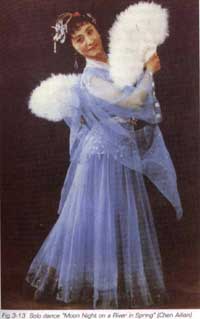 The music has the same melody as an ancient verse by Zhang Ruoxu. The famous poet of the Tang Dynasty created a magnificent scene when the "river and heaven mix together in the far distance and the bright moon hangs high in the sky alone". Graceful and soft body movements were employed to exquisitely express young girls' yearning for happiness. (Fig.3-13) The dance has been recognized as one of the Dance Classics of the Chinese Nation in the 20th Century.
The music has the same melody as an ancient verse by Zhang Ruoxu. The famous poet of the Tang Dynasty created a magnificent scene when the "river and heaven mix together in the far distance and the bright moon hangs high in the sky alone". Graceful and soft body movements were employed to exquisitely express young girls' yearning for happiness. (Fig.3-13) The dance has been recognized as one of the Dance Classics of the Chinese Nation in the 20th Century.
All the above programs were representative works from the 1950s and 1960s. They have survived the test of time. The choreographers and performers were all outstanding first generation dancers in new China. While receiving strict professional training, they paid much attention to learning from life and the masses. They pursued art and national dignity unremittingly, which well represented the spirit of the times.
After the 10 years of the "cultural revolution" (1966-1976), the badly destroyed art of dance recovered and entered a new development stage in China's reform and opening process.
During the historical social reform, people's ways of thinking, values, psychological state and aesthetic consciousness all changed noticeably. Traditional culture and ideology were re-examined and their position in the Chinese modernization drive re-evaluated. Various views appeared publicly in all kinds of fields, reflecting the people's active minds. Called on by Deng Xiaoping's thought of "seeking truth from facts and emancipating the minds", the policy of "letting a hundred ffowers blossom and a hundred schools of thought contend" was further promoted. The profound and comprehensive progress exerted a positive influence on development of the dancing art in this new period.
Before the "Culture revolution", dances were ironed with the marks of the time. Restrained by ideology and concepts at that time, choreographers were always afraid that their creations were too far away from people's works and lives in reality. As a result, they were cautious and identical in choosing themes and styles for dances. A kind of similarity and stereotype can be found in the process of creations during that time. After the "art renaissance" in the 1980s, many choreographers showed a strong desire to create new works. Though different in values and aesthetic awareness, they were eager to break through the common ways and styles in the past works, including the "Successful experiences". Consequently, a group of new and attractive works sprang up.
Choreographers growing up in the 1950s made great achievements. The "Brook, River and Sea", created jointly by a couple Huang Shaoshu (female, 1938- ) and Fang jinji (1931 - ) was the most striking one.
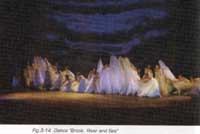 This is a female group dance which debuted in 1986. The lead performers were ZhangXiaoqing and Li Yinyin from the Dance Department of the Art Academy of the Chinese People's Liberation Army A group of girls, with water-colored long skirts made from gauzy silk, move forward in small, broken and smooth steps, like sparkling "water drops". They gradually change into the waves of rivers, with little tides rising and falling. Then these girls wave their skirts and silk, running and jumping in big strides, demonstrating vividly the surging and unceasing rivers. The whole dance creates a grand scene of mountain brooks congregating into rivers and then joining the sea, which brings to light the immutable laws governing human society (Fig.3-14)
This is a female group dance which debuted in 1986. The lead performers were ZhangXiaoqing and Li Yinyin from the Dance Department of the Art Academy of the Chinese People's Liberation Army A group of girls, with water-colored long skirts made from gauzy silk, move forward in small, broken and smooth steps, like sparkling "water drops". They gradually change into the waves of rivers, with little tides rising and falling. Then these girls wave their skirts and silk, running and jumping in big strides, demonstrating vividly the surging and unceasing rivers. The whole dance creates a grand scene of mountain brooks congregating into rivers and then joining the sea, which brings to light the immutable laws governing human society (Fig.3-14)
Dances with a strong sense of life were created one after another from the new generation of choreographers. For example: "Galloping" (a male group dance) appeared in 1986. (Choreographer: Ma Yue [of Hui nationality, 1945- ]; composers: ji Cheng and Xiao Ou; It was premiered by jiang Tiehong from the Dance Department of the Central Institute for Nationalities.) The leading dancer and the group set each other off, creating a magnificent scene of ten thousand horses galloping ahead with one taking the lead. The free people and galloping horses establish a Fig. full of vitality.
 The dance "Galloping" makes an important break-through in Mongolian dance. It does not only demonstrate the folk customs of the Mongolian people, but also reflects their feelings about life by showing their deep love for horses.The dance was awarded the first prize at the Second National Dance Competition. (Fig.3-15)
The dance "Galloping" makes an important break-through in Mongolian dance. It does not only demonstrate the folk customs of the Mongolian people, but also reflects their feelings about life by showing their deep love for horses.The dance was awarded the first prize at the Second National Dance Competition. (Fig.3-15)
The "Yellow River Cantata" is the immortal piece of the great Patriotic composer Xian Xinghai. On this basis, the "Yellow River Piano Concerto" was composed. Both of them are included in the Music Classics of the Chinese Nation in the 20th Century. It is a challenging new attempt to create a dance according to the classic. Su Shijin and Yuchi jianming took the lead. They created a male group dance "Yellow River Soul" in 1980, which was premiered by the Frontline Song and Dance Ensemble of the Nanjing Military District. The dance won the first prize in the First National Dance Competition in 1980.
The big group dance "yellow River" debuted in 1988. (Choreographer: Zhang Yujun [1962- ] and Yao Yong [1958- ]; first performed by The Beijing Dance Institute.) If we say the "Yellow River Cantata" expressed profoundly its own content by Outstanding music and poetic lines, the "Yellow River Piano Concerto" by Yin Chengzong can be said to be a distillation of the original music and a demonstration of piano techniques. Further more, the group dance "Yellow River" is expressed by body language.
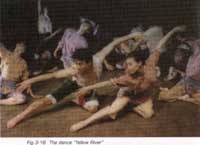 The dance keeps the original spirit and cream of the "Yellow River Piano Concerto". The dance movements are all in accordance with the original music, but not mechanically so. The dancers expound the musical theme with their bodies, expressing the soul of the Chinese nation. (Fig. 3-16)
The dance keeps the original spirit and cream of the "Yellow River Piano Concerto". The dance movements are all in accordance with the original music, but not mechanically so. The dancers expound the musical theme with their bodies, expressing the soul of the Chinese nation. (Fig. 3-16)
The group dance "Yellow Earth on Yellow Land" which premiered in 1990, moved people to the bottom of their hearts. (Choreographer: Zhang jigang; composer: Wang Zhenning; first performed by: Yu Xiaoxue and others from the Beijing Dance Institute.)
 A group of men with drums on their bare backs and a group of women in traditional Chinese garments on stage remind people of their parents and fellow villagers working on this yellow land for generations. They seem to just come out from "yellow clods". However, when they begin dancing one after another, beating deafening drums, stamping their feet, stretching their legs and almost making a pit on the ground, you feel that they have stepped into modern society. With their movements, they let out their feeling for the new society. By the endless and repeated drum sounds, they show their love for this yellow land, their longing for a world out of the mountain and their hopes for the future. The unusual actions, the repeating of the same movement and the shocking drums by those "crazy people" had never been seen in dances before. (Fig.3-17)
A group of men with drums on their bare backs and a group of women in traditional Chinese garments on stage remind people of their parents and fellow villagers working on this yellow land for generations. They seem to just come out from "yellow clods". However, when they begin dancing one after another, beating deafening drums, stamping their feet, stretching their legs and almost making a pit on the ground, you feel that they have stepped into modern society. With their movements, they let out their feeling for the new society. By the endless and repeated drum sounds, they show their love for this yellow land, their longing for a world out of the mountain and their hopes for the future. The unusual actions, the repeating of the same movement and the shocking drums by those "crazy people" had never been seen in dances before. (Fig.3-17)
The above works, though different in style, all show a strong sense of life, which is the call of the new era. The following two solo dances "Soul of a Peacock" and "Last Days of Spring" are on the same topic.
The "Soul of a Peacock" is a female solo dance which premiered in 1986 by Yang Liping (1958- ). She created the dance herself. Composers are Zhang Pingsheng and Wang Fujian.
 To see it in a simple way, the "Soul of a Peacock" symbolizes a peacock in appearance. But it is obviously different from the common peacock dances of the Dai nationality, whether they are performed in folk people or by artists. Yang named her dance "Soul of a Peacock" to show her pursuit for a profound meaning to the work. She imitated the peacocks' image of "standing erect against the wind", "jumping and spinning "and" flying with wings fully open", but far exceeding these basic images. She demonstrated the integration of the soul and body of a dancing "peacock". The special movements she created herself, Such as the vibration of the arms as if without bones and other tender and soft actions, give the audiences a sense of the vitality of life.The dance won the first prize in creation and performance at the Second National Dance Competition. (Fig.3-18)
To see it in a simple way, the "Soul of a Peacock" symbolizes a peacock in appearance. But it is obviously different from the common peacock dances of the Dai nationality, whether they are performed in folk people or by artists. Yang named her dance "Soul of a Peacock" to show her pursuit for a profound meaning to the work. She imitated the peacocks' image of "standing erect against the wind", "jumping and spinning "and" flying with wings fully open", but far exceeding these basic images. She demonstrated the integration of the soul and body of a dancing "peacock". The special movements she created herself, Such as the vibration of the arms as if without bones and other tender and soft actions, give the audiences a sense of the vitality of life.The dance won the first prize in creation and performance at the Second National Dance Competition. (Fig.3-18)
The "Last Days of Spring" is a male solo dance created by Sun Longkui (Korean, 1957- ). It debuted in 1988 accompanied by traditional Korean music. It was first performed by Yu Xiaoxue and others from the Beijing Dance Institute. It shares some similar ideas with the "Soul of a Peacock" in creation. Accompanied by melancholy singing, the dance expresses people's regret over the flying time and the shortness of youth while presenting an unrestrained enthusiasm for life with various body rhythms.
The Korean nationality mainly living at the foot of Changbai Mountains is good at singing and dancing. Female dances seem to be more famous. In the dance, Sun Longkui pushed the male dance to a higher level. Through his profound understanding of the Korean nationality and accurate grasp of dance movement, he actually renovated the traditional Korean dance. Modern dance techniques were integrated into the performance, Such as bending, twitching, twisting, jumping and spinning. The rhythm and way of breathing bring forth the outstanding features of Korean dance.
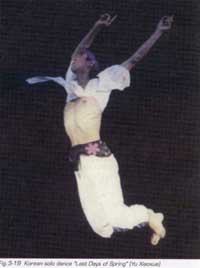 The creation won the first prize at the national "Taoli (Peach and Plum) Cup" invitation competition in 1988. (Fig.3-19)
The creation won the first prize at the national "Taoli (Peach and Plum) Cup" invitation competition in 1988. (Fig.3-19)
The above seven works-"Brook, River and Sea", "Galloping", "Last Days of Spring" "Yellow Earth on Yellow Land", "Yellow River" and "Soul of a Peacock"-are all confirmed as Dance Classics of the Chinese Nation in the 20th Century.
Chinese classical dance during that this period also saw rapid development. For example, the "Jinshan Battle Drum" is a female pas de trios which debuted in 1980. (Choreographer: Pang Zhiyang [1931- ] and Men Wenyuan [1934- ]; composer: Tian Dezhong; first performed by: Wang Xia, Liu Qian and Wang Yan from the Qianjin Song and Dance Ensemble of the Shenyang Military District of PLA.)
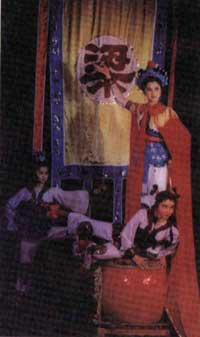 The work finds its origins in the deeds of a famous heroine Liang Hongyu about 900 years ago. At the critical moment of national crisis, Liang beat the drums herself to encourage the soldiers. Shot by an arrow, Liang continued fighting till the final victory, showing her bold spirit. With flexible and smooth stage adjustments, exquisite and Superb skills and simple and moving plots, the dancers demonstrate vividly a war scene where Liang Hongyu led her female army. The dance gives full justice to the fictitious feature of Chinese dramas but is not restrained by these dramas. Three persons on the stage create a scene of thousands of soldiers and ten thousand horses on a battlefield. The character Liang Hongyu, with a long red cloak, acts like the wind and stands like pines, impressing audiences a lot. (Fig.3-20)
The work finds its origins in the deeds of a famous heroine Liang Hongyu about 900 years ago. At the critical moment of national crisis, Liang beat the drums herself to encourage the soldiers. Shot by an arrow, Liang continued fighting till the final victory, showing her bold spirit. With flexible and smooth stage adjustments, exquisite and Superb skills and simple and moving plots, the dancers demonstrate vividly a war scene where Liang Hongyu led her female army. The dance gives full justice to the fictitious feature of Chinese dramas but is not restrained by these dramas. Three persons on the stage create a scene of thousands of soldiers and ten thousand horses on a battlefield. The character Liang Hongyu, with a long red cloak, acts like the wind and stands like pines, impressing audiences a lot. (Fig.3-20)
The dance won the first prize at the First National Dance Competition and was included in the Dance Classics of the Chinese Nation in the 20th Century.
The pas de deux "Farewell of a New Couple" debuted in 1984. (Choreographers: Chen Zemei and Qiu Youren; composers, Zhang Xiaofeng and Zhu Xiaogu; first performed by: Shen Peiyi and Li Hengda from the Beijing Dance Institute.) The works comes from a poem by Du Fu, a famous poet in the Tang Dynasty It shows the theme of being loyal and dedicated to one's country and being exceedingly sentimental.
In the bridal chamber lit by red candles, the bride is waiting for her husband, shy and worrying. She is thinking about the beautiful life they will have after the marriage. But the reality is that the husband has to go to the battlefield immediately. The crow of cocks and the sound of bugle interrupt the pas de deux, and the moment for the life-and-death departure finally comes. At last, the wife gives the long knife to the husband resolutely and sends him to the war.The sleeve movement that is specially found in Chinese classical dance helps concisely depict the characters in the "Farewell of a New Couple". It won the first prize at the Second National Dance Competition.
It is not easy to make a final conclusion about the recently-created modern Chinese dances. But we can accurately say that the dances of modern time have seen comprehensive development after its recovery in the 1980s. The number of works has been increasing and the themes, styles, forms and the choreography have all become more diversified as a result of the society's reforming and opening mind.
